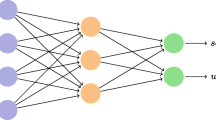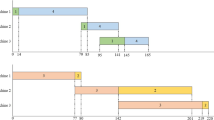Abstract
During automated problem solving it may happen that some knowledge that is known at the user level is lost in the formal model. As this knowledge might be important for efficient problem solving, it seems useful to re-discover it in order to improve the efficiency of the solving procedure. This paper compares three methods for discovering certain implied constraints in the constraint models describing manufacturing (and other) processes with serial, parallel, and alternative operations. In particular, we focus on identifying equivalent nodes in the precedence graph with parallel and alternative branches. Equivalent nodes correspond to operations that either must be all simultaneously present or none of them can be present in the schedule. Such information is frequently known at the user level, but it is lost in the formal model. The paper shows that identifying equivalent nodes is an NP-hard problem in general, but it is tractable if the graph has a nested structure. As the nested structure is typical for real-life processes and workflows, we use the nested graphs to experimentally compare the proposed methods.
Similar content being viewed by others
References
Barták, R. (2007). Generating implied Boolean constraints via singleton consistency. In LNAI : Vol. 4612. Abstraction, reformulation, and approximation (SARA 2007) (pp. 50–64). New York: Springer.
Barták, R., & Čepek, O. (2007). Nested temporal networks with alternatives. In Technical Report WS-07-12. Papers from the 2007 AAAI workshop on spatial and temporal reasoning (pp. 1–8). Menlo Park: AAAI Press.
Barták, R., Čepek, O., & Surynek, P. (2007). Modelling alternatives in temporal networks. In Proceedings of the 2007 IEEE symposium on computational intelligence in scheduling (CI-Sched 2007) (pp. 129–136). New York: IEEE Press.
Beck, J. Ch., & Fox, M. S. (2000). Constraint-directed techniques for scheduling alternative activities. Artificial Intelligence, 121, 211–250.
Beeri, C., Fagin, R., Maier, D., & Yannakakis, M. (1983). On the desirability of acyclic database schemes. Journal of the ACM, 30, 479–513.
Bessiere, C., Coletta, R., & Petit, T. (2007) Learning implied global constraints, In Proceedings of twentieth international conference on artificial intelligence (IJCAI 07) (pp. 44–49).
Brélaz, D. (1979). New methods to color the vertices of a graph. Communications of the ACM, 22, 251–256.
Charnley, J., Colton, S., & Miguel, I. (2006) Automatic generation of implied constraints, In Proceedings of 17th European conference on artificial intelligence (ECAI 06) (pp. 73–77).
Crowston, W., & Thompson, G. L. (1967). Decision CPM: A method for simultaneous planning, scheduling, and control of projects. Operations Research, 15, 407–426.
Dechter, R. (2003). Constraint processing. Los Altos: Kaufmann.
Dechter, R., Meiri, I., & Pearl, J. (1991). Temporal constraint networks. Artificial Intelligence, 49, 61–95.
Erol, K., Nau, D., & Hendler, J. (1994). HTN planning: Complexity and expressivity. In Proceedings of AAAI-94 (pp. 1123–1128). Menlo Park: AAAI Press.
Focacci, F., Laborie, P., & Nuijten, W. (2000) Solving scheduling problems with setup times and alternative resources, In Proceedings of AIPS 2000.
Frisch, A. M., Miguel, I., & Walsh, T. (2001) Generating implied constraints via proof planning, In Proceedings of the IJCAR-01 workshop on future directions in automated reasoning (pp. 48–55).
Garey, M. R., & Johnson, D. S. (1979). Computers and intractability: A guide to the theory of NP-completeness. San Francisco: Freeman.
Horling, B., Leader, V., Vincent, R., Wagner, T., Raja, A., Zhang, S., Decker, K., & Harvey, A. (1999) The taems white paper. University of Massachusetts, http://mas.cs.umass.edu/research/taems/white/taemswhite.pdf.
Kim, P., Williams, B., & Abrahmson, M. (2001) Executing reactive, model-based programs through graph-based temporal planning, In Proceedings of IJCAI-2001 (pp. 487–493).
Kuster, J., Jannach, D., & Friedrich, G. (2007) Handling alternative activities in resource-constrained project scheduling problems, In Proceedings of twentieth international joint conference on artificial intelligence (IJCAI-07) (pp. 1960–1965).
Nuijten, W., Bousonville, T., Focacci, F., Godard, D., & Le Pape, C. (2003) MaScLib: Problem description and test bed design. http://www2.ilog.com/masclib.
Tsamardinos, I., Vidal, T., & Pollack, M. E. (2003). CTP: A new constraint-based formalism for conditional temporal planning. Constraints, 8(4), 365–388.
Van Beek, P., & Dechter, R. (1994) Constraint tightness versus global consistency, In Proceedings of knowledge representation (KR-94) (pp. 572–582).
Author information
Authors and Affiliations
Corresponding author
Rights and permissions
About this article
Cite this article
Barták, R., Čepek, O. & Surynek, P. Discovering implied constraints in precedence graphs with alternatives. Ann Oper Res 180, 233–263 (2010). https://doi.org/10.1007/s10479-008-0492-1
Published:
Issue Date:
DOI: https://doi.org/10.1007/s10479-008-0492-1




